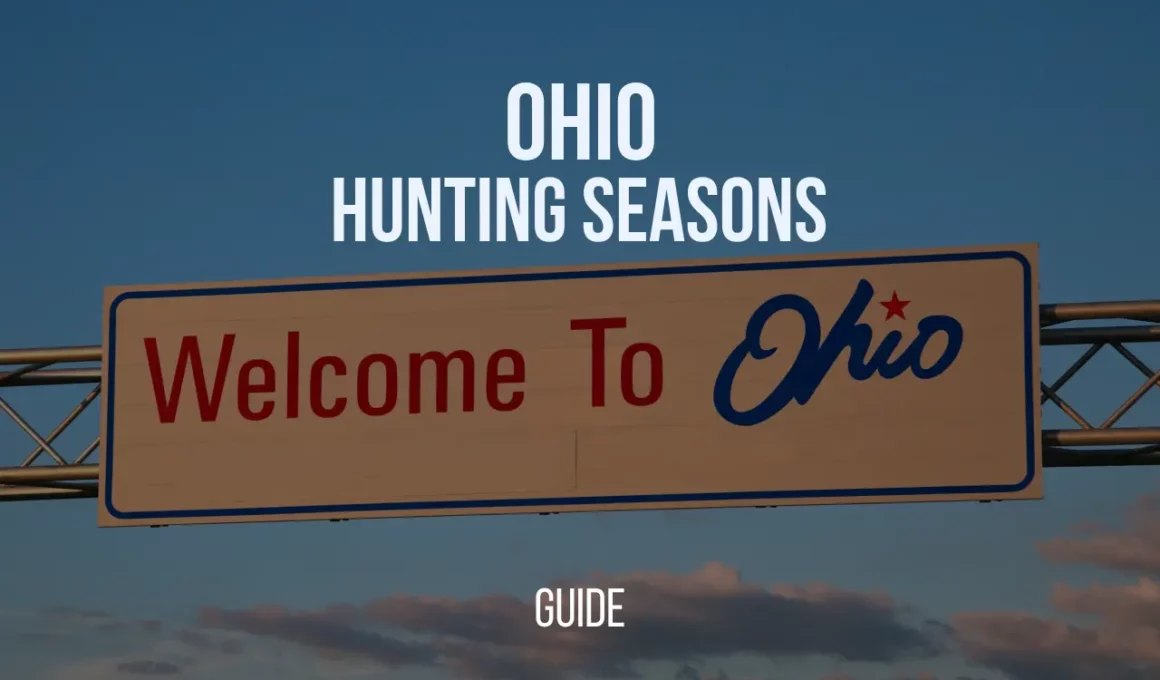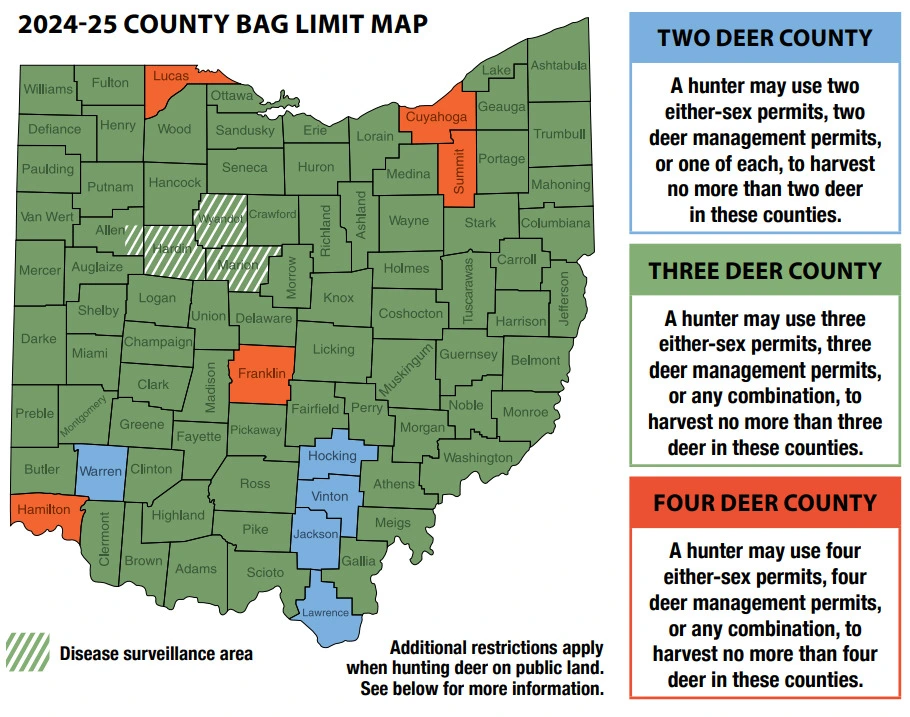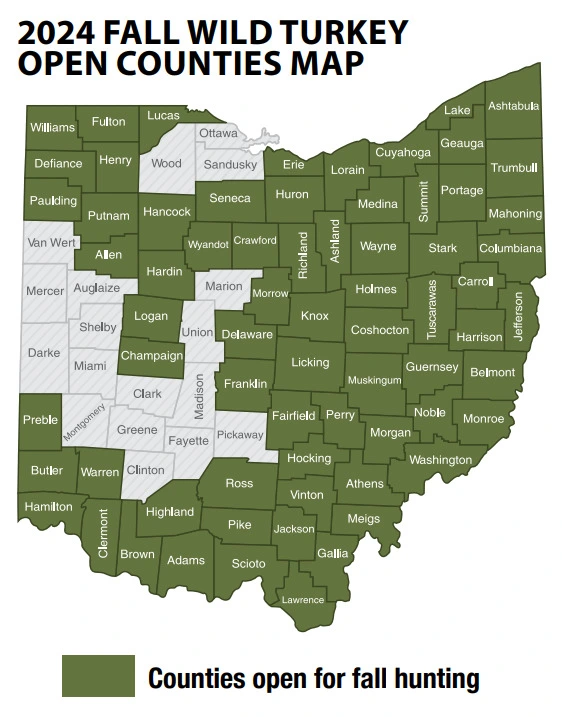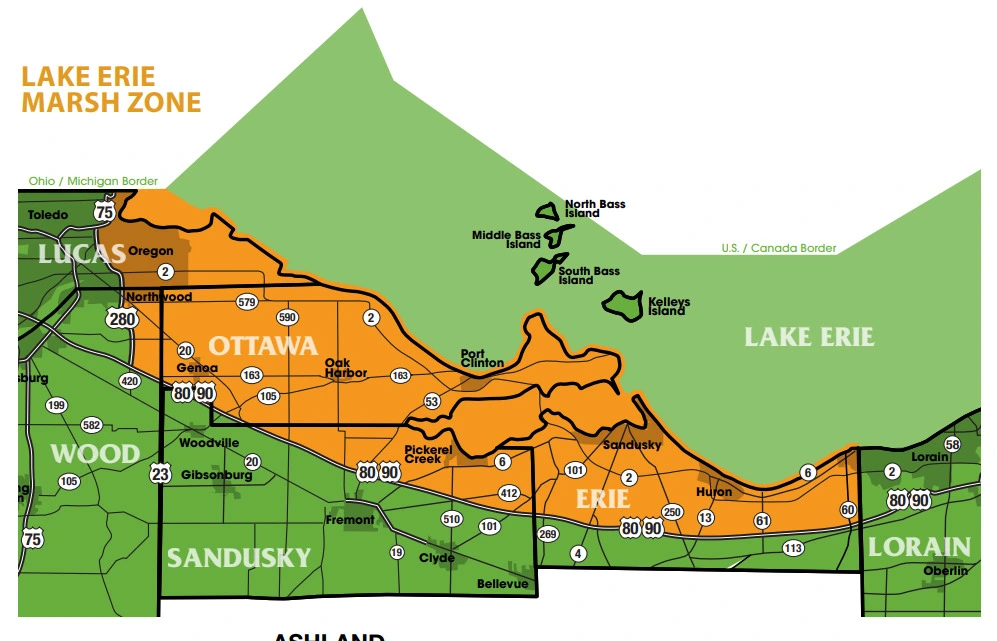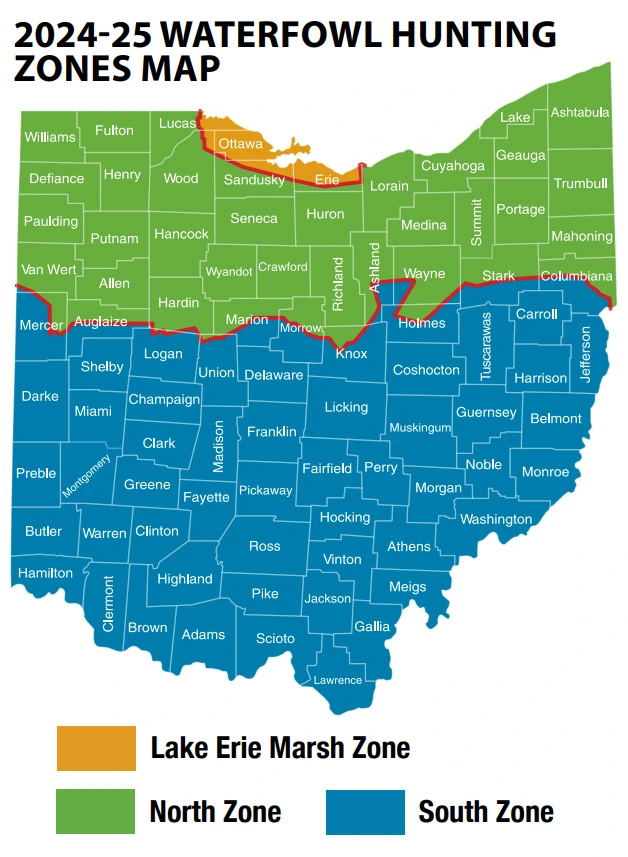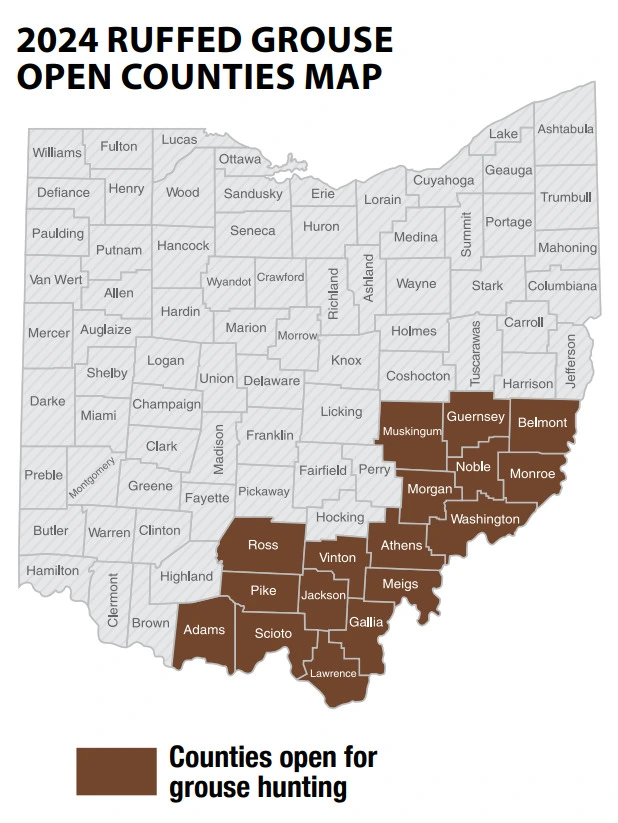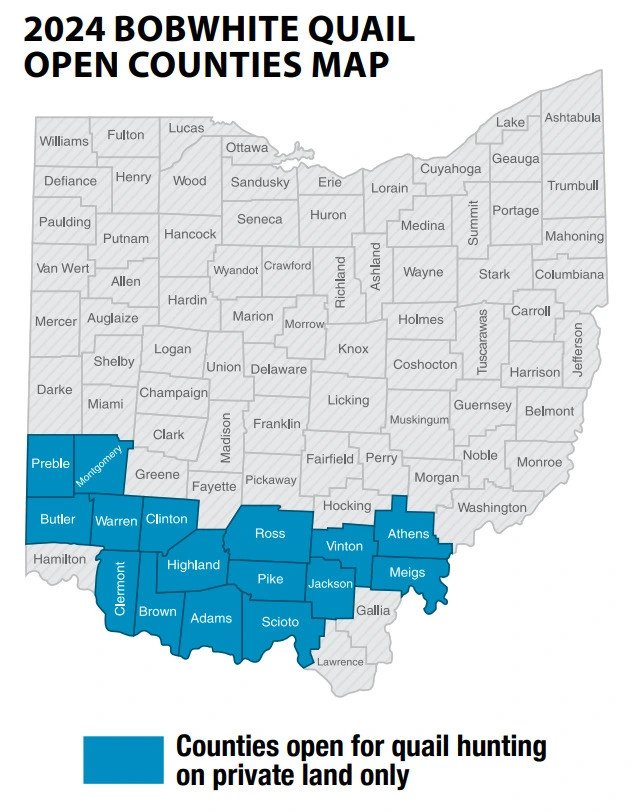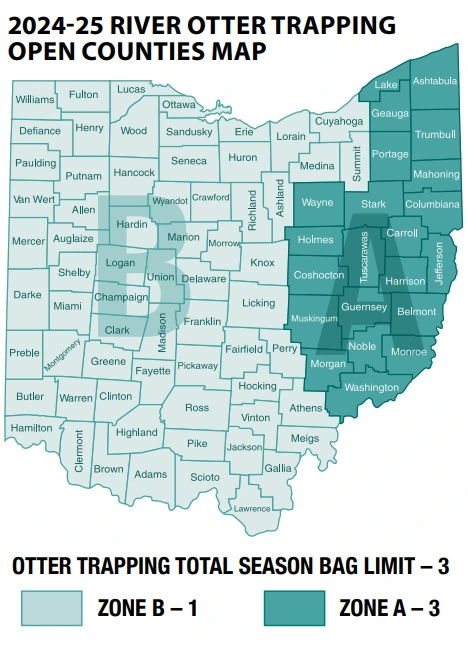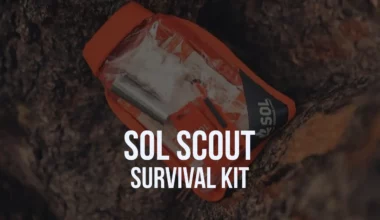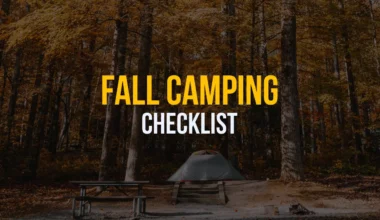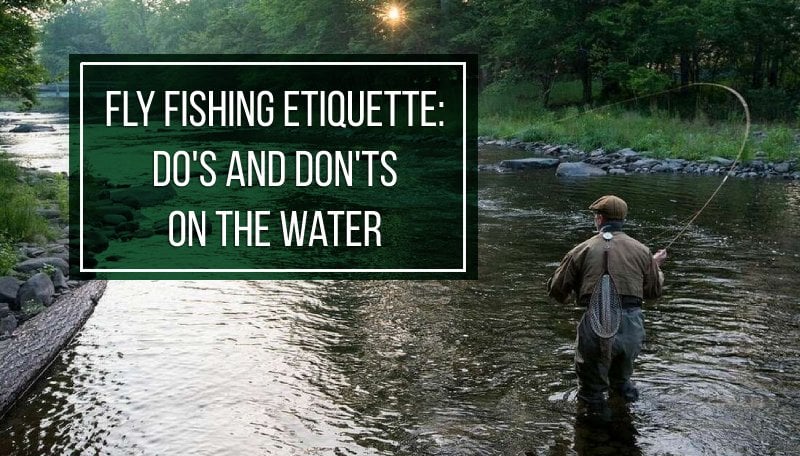If you’re a new hunter in the Buckeye State, this comprehensive guide will provide you with essential information and updates for the upcoming Ohio hunting seasons. From understanding residency requirements and obtaining your hunting license to navigating the specific regulations for game species, this resource will ensure you are well-prepared and informed. Get ready to make the most of your hunting opportunities in Ohio for the 2024-2025 season.
Ohio Hunting Season Dates by Game Species
Ohio Hunting Licenses & Permits
🎫
Youth – anyone 17 years old and younger.
Resident Adult – Ohio residents age 18-65.
Nonresident Adult – all nonresidents 18 years old and older.
Apprentice – residents and nonresidents accompanied by a licensed hunter.
Resident Senior – Ohio residents age 66 and older born on or after January 1, 1938.
Resident Free Senior – Ohio residents born on or before December 31, 1937.
Ohio Youth Hunting License Fees
| Resident & Nonresident Youth 1-Year Hunting License | $10.00 |
| Resident & Nonresident Youth 1-Year Apprentice License | $10.00 |
| Resident Youth 3-Year Hunting License | $27.04 |
| Resident Youth 5-Year Hunting License | $45.07 |
| Resident Youth 10-Year Hunting License | $90.14 |
| Resident Youth Lifetime Hunting License | $430.56 |
Ohio Adult Hunting License Fees
| Resident 1-Year Hunting License | $19.00 |
| Resident 1-Year Apprentice License | $19.00 |
| Resident 3-Year Hunting License | $54.08 |
| Resident 5-Year Hunting License | $90.14 |
| Resident 10-Year Hunting License | $180.27 |
| Resident Lifetime Hunting License | $449.28 |
| Nonresident 1-Year Hunting License | $180.96 |
Nonresident (Tourist) 3-Day Hunting License Nonresident 3-day license not valid for deer, turkey, or furbearers | $40.56 |
| Nonresident 1-Year Apprentice Hunting License | $180.96 |
Ohio Senior Hunting License Fees (residents only)
| Resident Senior 1-Year Hunting License | $10.00 |
| Resident Senior 1-Year Apprentice License | $10.00 |
| Resident Senior 3-Year Hunting License | $27.04 |
| Resident Senior 5-Year Hunting License | $45.07 |
| Resident Senior Lifetime Hunting License | $84.24 |
| Resident Free Senior Hunting License | free |
Ohio Hunting Licenses: Residency Status, Requirements & More
- Ohio Residency Status
- An Ohio resident: Must have resided in Ohio for the past 6 consecutive months.
- Nonresidents: Must purchase a nonresident license.
- Nonresident students: Qualify for a resident license if enrolled full-time at an Ohio college/university and living in Ohio at purchase time.
- Hunting Licenses
- Annual licenses: Valid from March 1 to the last day in February.
- Multiyear licenses: Valid for three, five, or ten years from the purchase date.
- Costs: Include a writing fee; transaction fees may apply for online/in-app purchases.
- Policies: All sales final; no refunds.
- License requirement: All hunters, regardless of age, must carry a valid license.
- Additional permits: Required for hunting specific game (deer, turkey, waterfowl, furbearers).
- License print: Purchased licenses are printed on plain white paper; protect from elements.
- Customer presence: Required to purchase a license or permit.
- Duplicate Licenses & Permits
- Re-issuance: Lost, stolen, or destroyed licenses can be re-issued at any license sales location or at wildohio.gov.
- Reprint costs: Free at wildohio.gov; $4 at a license agent.
- License Requirements
- Customer ID: Permanent identification number assigned to all applicants.
- Social Security Number (SSN): Required for all applicants; affirmation needed for those without an SSN.
- Residency declaration: Applicants must provide personal information (name, date of birth, gender, address, height, weight, hair colour, eye colour).
- Information update: Only required if changes occur.
- Purchase a Hunting License
- Locations: Purchase at authorized agents, HuntFish OH app, or wildohio.gov.
- Agent locator: Available at wildohio.gov or by calling 1-800-WILDLIFE (1-800-945-3543).
- Electronic Licenses
- Purchase options: Available on mobile devices or through the HuntFish OH app.
- Carry requirements: Hunters must carry licenses and permits at all times and present upon request; can be displayed on mobile devices.
🦌
Deer Season Dates in Ohio
*DSA – Disease Surveillance Areas.
DSA include: All of Hardin, Marion, and Wyandot counties; Augalize and Jackson townships in Allen County
Deer Archery:
Statewide: Sept. 28, 2024 – Feb. 2, 2025
DSA: Sept. 14, 2024 – Feb. 2, 2025
Youth Deer Gun:
Statewide: Nov. 16 – Nov. 17
Deer taken during the youth gun season counts toward county and statewide bag limits.
Deer Gun:
DSA Early Season: Oct. 12, 2024 – Oct. 14, 2024
Statewide: Dec. 2, 2024 – Dec. 8, 2024 / Dec. 21, 2024 – Dec. 22, 2024
Deer Muzzleloader:
Statewide: Jan. 4, 2025 – Jan. 7, 2025
Ohio Deer Hunting: Permits, Rules, and Regulations
Bag limit:
- Statewide limit: 6 deer; only 1 may be antlered. Antlered deer must have at least 1 antler 3 inches or longer.
- Hunters may combine county harvests to meet the statewide limit.
- Two Deer Counties: Harvest limit of 2 deer using:
- 2 either-sex permits, or
- 2 deer management permits, or
- 1 of each.
- Three Deer Counties: Harvest limit of 3 deer using:
- 3 either-sex permits, or
- 3 deer management permits, or
- Any combination.
- Four Deer Counties: Harvest limit of 4 deer using:
- 4 either-sex permits, or
- 4 deer management permits, or
- Any combination.
- Hunting on public land:
- Limit of 1 antlerless deer per license year.
- Public hunting areas list available at wildohio.gov.
- Exemptions: Authorized Division of Wildlife controlled hunts; Andreoff, Big Island, Wyandot, Lake La Su An, and Killdeer Plains wildlife areas.
Hunting Hours:
30 minutes before sunrise – 30 minutes after sunset.
Deer Hunting Permits:
- Hunters in Ohio must have a valid hunting license and purchase either an either-sex deer permit or a deer management permit, unless exempt.
- Either-sex deer permit:
- Can be used to hunt either antlered or antlerless deer.
- Valid statewide: Sept. 28, 2024 – Feb. 2, 2025
- Valid in DSA: Sept. 14, 2024 – Feb. 2, 2025
- Purchase individually throughout the deer season.
- Deer management permit:
- For taking antlerless deer only.
- Valid during all deer hunting seasons and controlled hunts.
- Valid statewide: Sept. 28 – Dec. 22, 2024
- Valid in DSA: Sept. 14 – Dec. 22, 2024
- Not valid in public hunting areas, except:
- Andreoff
- Big Island
- Killdeer Plains
- Lake La Su An
- Wyandot wildlife areas
- Authorized controlled hunts
Either-Sex Deer Permit Fees
| Adult Permit: Resident | $31.20 |
| Adult Permit: Nonresident | $76.96 |
| Youth Permit: Resident & Nonresident | $16.00 |
| Senior Permit: Resident Only | $12.00 |
| Free Senior Permit: Resident Only | Free |
Deer Management Permit Fees
| Adult and Youth Permit: Resident & Nonresident | $15.00 |
| Senior Permit: Resident Only | $15.00 |
| Free Senior Permit: Resident Only | Free |
Tag & Check:
Legal Deer Hunting Equipment
You can carry only 1 hunting implement while hunting deer.
Archery Season:
- Longbow or Bow: Minimum draw weight of 40 pounds; arrow tip must have at least 2 cutting edges and a minimum width of 3/4-inch; expandable and mechanical broadheads are legal.
- Crossbow: Minimum draw weight of 75 pounds; arrow tip must have at least 2 cutting edges and a minimum width of 3/4-inch; expandable and mechanical broadheads are legal.
Gun Season:
- Shotgun: 10 gauge or smaller, using 1 ball or 1 rifled slug per barrel (rifled shotgun barrels permitted for shotgun slug ammo).
- Straight-walled cartridge rifles: All calibers from .357 to .50 (includes .350 Legend); no more than 3 shells in the chamber and magazine combined.
- Archery equipment legal during the Archery Season.
- Muzzleloading rifle: .38 caliber or larger.
- Muzzleloading shotgun: 10-gauge or smaller using 1 ball per barrel.
- Handgun: Minimum barrel length of 5 inches using straight-walled cartridges of .357 caliber or larger.
Muzzleloader Season:
- Muzzleloading rifle: .38 caliber or larger.
- Muzzleloading shotgun: 10-gauge or smaller using one ball per barrel.
- Archery equipment legal during the Archery Season.
Deer Hunting Regulations Highlights:
- Youth Season Blaze Orange: All youths and non-hunting adults must wear required hunter orange clothing during the youth season.
- Public Hunts: Hunters cannot hunt deer over bait in public hunting areas.
- DSA Rules:
- Bait (salt, minerals, food) use to attract deer within DSA boundaries is prohibited.
- Normal agricultural activities and hunting deer over crops or food plots are allowed in the DSA.
- Protect Ohio’s Deer Herd:
- Dispose of deer carcasses properly; double-bag high-risk parts (brain, spinal cord, eyes, lymphoid tissues) in household trash.
- It is illegal to bring high-risk carcass parts into Ohio or remove them from a DSA unless delivered to certified wildlife processor or taxidermist within 24 hours.
- Report sick or abnormal-acting deer or those with visible ear tags to the Division of Wildlife.
- Hunting Other Game During Deer Firearm Seasons:
- Waterfowl: No hunter orange required; all shot sizes allowed.
- Coyote and Feral Swine: Hunter orange required; hunt only during legal deer season hours with legal deer hunting equipment and valid permits.
- Furbearers (except Coyote): Hunt with a shotgun using No. 4 shot or smaller during legal deer season hours; hunter orange required. Exempt 30 minutes after sunset and 30 minutes before sunrise.
- All Other Game: Hunt with a shotgun using No. 4 shot or smaller; hunter orange required.
- Mandatory Sampling for Deer Harvested within the DSA
- Required for ALL deer harvested on Oct. 12-13 and Dec. 2-3.
- Staffed sampling locations available on mandatory days at specified addresses.
- Self-serve kiosks available for deer drop-off throughout the season.
- Participation is voluntary outside the four mandatory days.
- Kiosk locations and operating dates can be found at wildohio.gov.
- Instructions for sample submission provided at kiosks.
- Sampling Locations:
- Big Island Wildlife Area Headquarters: 5389 Larue-Prospect Rd West, New Bloomington, OH 43341
- Killdeer Plains Wildlife Area Headquarters: 19100 CH 115 Harpster, OH 43323
- Wyandot County Fairgrounds: 10171 OH 53 Upper Sandusky, OH 43351
- Rural King: 233 American Blvd Marion, OH 43302
- Hardin County Fairgrounds: 14134 County Road 140 Kenton, OH 43326
- McGuffey Conservation Club: 6950 Township Road 55 Ada, OH 45810
A DEER HUNTER MAY DO THE FOLLOWING:
- A successful deer hunter may assist another hunter if the deer permit is completed, no hunting implements are carried, and a valid hunting license is held. Those exempt from needing a hunting license and deer permit on their property must obtain these to aid another hunter or hunt deer off their property.
- Harvest more than 1 deer per day if recorded on the permit or submitted to game check.
- Hunt deer over bait (not on public land or in DSA).
- Leave deer or parts with taxidermists, fur buyers, or processors, ensuring a confirmation code is attached.
- Carry a printed or electronic copy of the deer permit.
- Possess a communication device.
- Use a leashed dog to recover a wounded deer.
- Archery hunt during youth deer gun season if not accompanying another hunter and wearing hunter orange.
A DEER HUNTER MAY NOT DO THE FOLLOWING:
- Pursue wounded or recover dead deer, including shed antlers, from private property without landowner permission.
- Hunt with a shotgun or rifle loaded with more than 3 shells in the magazine and chamber combined. Doesn’t apply to handguns.
- Possess a loaded firearm during deer firearms seasons only from 30 minutes before sunrise to 30 minutes after sunset. Muzzleloading firearms are deemed unloaded if the cap, priming powder, or battery is removed.
- Hunt deer with a muzzleloading handgun.
- Carry more than 1 hunting firearm when hunting deer.
- Attach any mechanical, electrical, or electronic device that projects a visible beam of light to a longbow or crossbow, except for non-visible light devices like range finders.
- Possess shotshells containing shot during deer gun seasons.
- Use dogs to hunt deer.
- Use permits purchased after the deer was harvested for checking.
- Construct or place permanent tree stands or alter trees on public or private lands without permission.
- Check a deer as a landowner if the hunter is a tenant, unless they live on the rented property and derive most of their income from agricultural production on that land.
- Submit game checks under another person’s account.
- Carry a firearm while hunting with a longbow or crossbow (except concealed handguns).
- Use drones or aircraft in hunting, except for recovering harvested deer.
Deer Carcass Regulations
- Possessing high-risk carcass parts from Cervids (deer, moose, elk, caribou) harvested outside Ohio or from a disease surveillance area is prohibited to minimize CWD spread.
- Permissible parts from imported Cervids or those removed from a disease surveillance area include:
- De-boned meat
- Meat cut and securely wrapped (no spinal column or head)
- Quarters or portions of meat (no spinal column or head)
- Antlers
- Antlers attached to a skull cap (all soft tissue removed)
- Upper canine teeth (all soft tissue removed)
- Hides and capes (no head or lymph nodes)
- Finished taxidermy mounts
- Soft body tissue wrapped for diagnostic research
- Out-of-state hunters in Ohio may possess Cervid carcasses (or parts) if not off-loaded from the vehicle.
- Returning hunters with complete Cervid carcasses or parts not on the list must present them to a certified taxidermist or processor within 24 hours of entering Ohio or leaving a disease surveillance area.
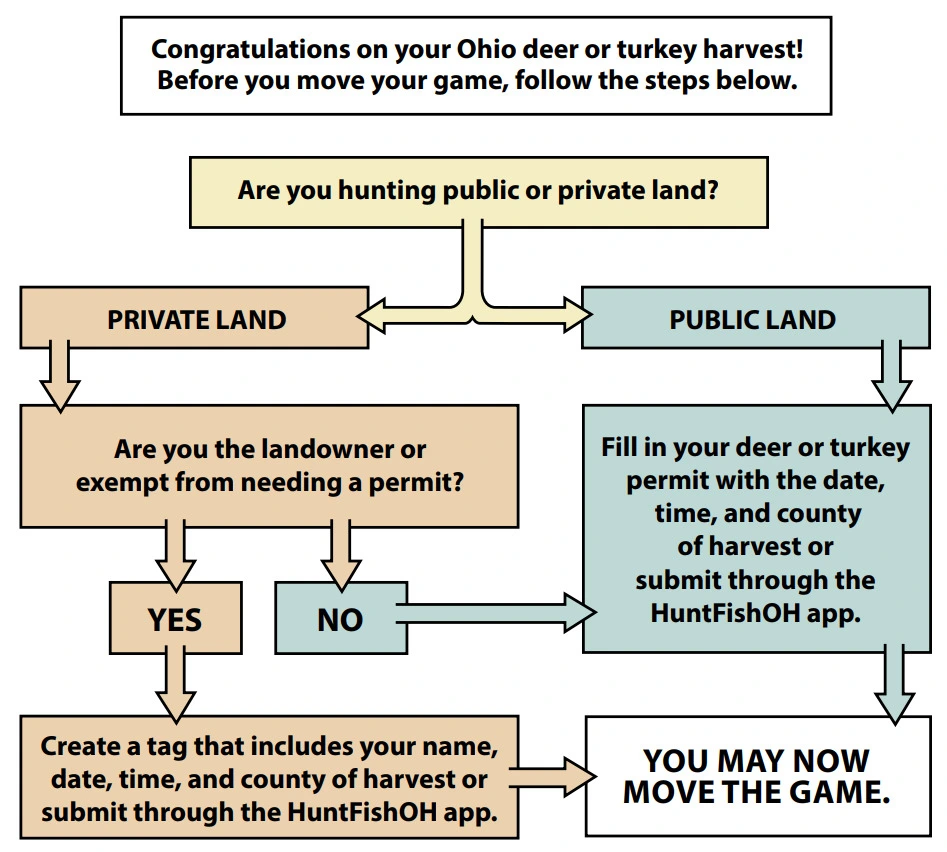
- All hunters harvesting white-tailed deer or wild turkey must complete the game check process.
- For white-tailed deer:
- Complete the game check and receive a confirmation code by noon the day after the kill.
- If killed on the last day of the season, it must be checked in by 11:30 p.m. that day.
- For wild turkey:
- Complete the game check and receive a confirmation code by 11:30 p.m. on the same day it was killed.
Fill in the Permit or Tag
- Fill in the deer or wild turkey permit immediately upon harvest before moving the carcass, including date, time, and county of kill. Submission via the Division of Wildlife’s mobile application meets this requirement; temporary tags or mobile photos do not. Tagging is required once the hunter leaves the animal unattended or arrives at home or temporary lodging.
- Exempt landowners must create a tag including their name, date, time, and county. Submission via the Division of Wildlife’s mobile application meets this requirement. The tag for exempt landowners may remain unattached until the animal is left unattended or they reach a residence or temporary lodging.
- Once the game is unattended, the completed permit, tag, or confirmation code must be attached and remain with the game at all times.
- Additional information:
- Hunters must provide a 10-digit permit number; exempt landowners do not need to do so.
- Hunters must answer a series of questions during the game check process.
- A confirmation code will be issued at the end of the process.
- The confirmation code can be written on the permit or tag and attached to the game.
- Online, agent, or mobile application checks result in a game check receipt with the confirmation code.
- Telephone checks provide the confirmation code verbally.
- Mobile app users receive their confirmation code once their phone has service.
- The confirmation code must remain attached to the game and its parts, and may be written on the back or bottom of a mount.
- A game check receipt can be printed at ohiogamecheck.com after the game check.
- The game check must be completed before skinning or removing the head from a deer and before removing parts from a wild turkey, excluding field dressing.
🦃
Wild Turkey Season Dates in Ohio
Fall Turkey:
Select counties: Oct. 1 – Oct. 27
Spring Turkey:
To be announced
Ohio Deer Hunting: Permits, Rules, and Regulations
Bag limit (fall):
- Statewide limit: 1 of either sex
Hunting hours (fall):
30 minutes before sunrise – sunset.
Fall Turkey Permit Fees
| Adult Permit: Resident | $31.20 |
| Adult Permit: Nonresident | $38.48 |
| Youth Permit: Resident & Nonresident | $16.00 |
| Senior Permit: Resident Only | $12.00 |
| Free Senior Permit: Resident Only | Free |
Spring Turkey Permit Fees
| Adult Permit: Resident | $31.20 |
| Adult Permit: Nonresident | $38.48 |
| Youth Permit: Resident & Nonresident | $16.00 |
| Senior Permit: Resident Only | $12.00 |
| Free Senior Permit: Resident Only | Free |
Tag & Check:
Legal Turkey Hunting Equipment
- Shotgun:
- 10-gauge or smaller
- Muzzleloading shotguns permitted
- Longbow or Bow:
- Minimum draw weight: 40 pounds
- Types: compound and recurve bows
- Arrow tip: minimum 2 cutting edges, exposed or unexposed, 3/4-inch width
- Expandable and mechanical broadheads legal
- Crossbow:
- Minimum draw weight: 75 pounds
- Arrow tip: minimum 2 cutting edges, exposed or unexposed, 3/4-inch width
- Expandable and mechanical broadheads legal
Turkey Hunting Regulations:
- Hunting wild turkeys with bait is unlawful; an area is considered baited for 10 days after bait removal.
- Live decoys are prohibited while hunting wild turkeys.
- Use of electronic calling devices while hunting wild turkeys is unlawful.
- Attempting to take a wild turkey while it is in a tree is prohibited.
- Only 1 hunting implement may be possessed while turkey hunting.
- Successful turkey hunters may assist others if:
- The turkey permit is filled in.
- They do not carry a hunting implement commonly used for killing wild animals.
- They possess a valid hunting license.
- Individuals exempt from needing a hunting license and permits for turkey hunting on their property must obtain a hunting license and turkey permit to assist others or hunt off their property.
- Fall Wild Turkey Season
- Valid Ohio hunting license and fall turkey permit required, unless exempt
- Dogs may be used to assist in hunting
- Spring Wild Turkey Season
- Illegal to take or possess a wild turkey without a visible beard
- Valid Ohio hunting license and spring turkey permit required, unless exempt
- Leashed dogs can be used to recover wounded turkeys
- Youth Wild Turkey Season
- Valid hunting license and wild turkey permit required, unless exempt
- Hunting hours: 30 minutes before sunrise to sunset
🦆
Ohio Waterfowl Hunting Season Dates
Hunting hours: 30 minutes before sunrise to sunset during the regular waterfowl season, unless posted.
Youth/Military Waterfowl Season:
Statewide: Sept. 28, 2024 – Sept. 29, 2024
Active duty military, veterans, and youth may hunt together; the hunter must be a veteran or active military member.
Lake Erie Marsh Zone:
Geese: Oct. 12, 2024 – Oct. 27, 2024 / Nov. 16, 2024 – Feb. 3, 2025
Ducks, Coots & Mergansers: Oct. 12, 2024 – Oct. 27, 2024 / Nov. 9, 2024 – Dec. 22, 2024
North Zone:
Geese: Oct. 19, 2024 – Oct. 27, 2024 / Nov. 9, 2024 – Feb. 3, 2025
Ducks, Coots & Mergansers: Oct. 19, 2024 – Oct. 27, 2024 / Nov. 16, 2024 – Jan. 5, 2025
South Zone:
Geese: Oct. 19, 2024 – Oct. 27, 2024 / Nov. 16, 2024 -Feb. 10, 2025
Ducks, Coots & Mergansers: Oct. 19, 2024 – Oct. 27, 2024 / Dec. 7, 2024 – Jan. 26, 2025
Ohio Waterfowl Bag Limits
Lake Erie Marsh Zone, North Zone, South Zone
- Geese:
- 5 combined: Canada goose, white-fronted goose, and no more than 1 brant.
- 10 combined: snow goose, blue goose, Ross’s goose.
- Ducks:
- Daily bag limit: 6 ducks, including:
- no more than 4 mallards (maximum 2 hens)
- 3 wood ducks
- 2 redheads
- 2 canvasbacks
- 1 pintail
- 2 black ducks
- 1 mottled duck
- 1 scaup during the first 15 days; 2 scaup during the next 45 days.
- Daily bag limit: 6 ducks, including:
- Mergansers & Coots:
- 5 mergansers (maximum 2 hooded)
- 15 coots
Youth, Military:
- Same as the regular season
Ohio Migratory Bird Hunting Season Dates
Hunting hours: sunrise to sunset, unless posted.
Dove (Mourning and Eurasian collared):
Season: Sept. 1, 2024 – Nov. 3, 2024 / Dec. 7, 2024 – Jan. 1, 2025
Daily limit: 15
Early Canada Goose:
Season: Sept. 7, 2024 – Sept. 15, 2024
Daily limit: 5
Early Teal (Blue-winged, Green-winged & Cinnamon):
Season: Sept. 7, 2024 – Sept. 22, 2024
Daily limit: 6
Rail (Virginia, Sora):
Season: Sept. 1, 2024 – Nov. 9, 2024
Daily limit: 25
Gallinules:
Season: Sept. 1, 2024 – Nov. 9, 2024
Daily limit: 15
Wilson’s Snipe:
Season: Sept. 1, 2024 – Nov. 20, 2024 / Dec. 7, 2024 Jan. 1, 2025
Daily limit: 8
American Woodcock:
Season: Oct. 12, 2024 – Nov. 25, 2024
Daily limit: 3
Ohio Waterfowl & Migratory Bird Hunting: Permits, Rules, and Regulations
Possession limits:
- 3 times the daily bag limit after the second day.
Tagging Requirements:
- Migratory game birds must not be left at any location (excluding personal residence) or with another person for various purposes without a tag.
- The tag must be signed by the hunter and include:
- Hunter’s address
- Total number and species of birds
- Date of kill
- Birds transported as personal baggage in a vehicle are not classified as being in storage or temporary storage.
Migratory Bird & Waterfowl Stamp Fees
| Federal Migratory Bird Hunting Stamp | $25.00 |
| Ohio Wetlands Habitat Stamp: Resident & Nonresident | $15.00 |
| Free Senior Ohio Wetlands Habitat Stamp: Resident Only | Free |
Permits, Licenses, Duck Stamp, HIP Survey:
- Documents required to hunt migratory birds in Ohio:
- Valid Ohio hunting license.
- Harvest Information Program (HIP) certification.
- Documents required to hunt waterfowl in Ohio:
- Valid Ohio hunting license.
- Harvest Information Program (HIP) certification.
- Ohio Wetlands Habitat Stamp endorsement required for ages 18 and older.
- Signed federal Migratory Bird Hunting Stamp (Duck Stamp) or federal Electronic Duck Stamp (E-stamp) required for ages 16 and older.
Ohio Wetlands Habitat Stamp:
- The Ohio Wetlands Habitat Stamp is not issued at the time of purchase.
- A license will be provided indicating the Ohio Wetlands Stamp.
- The stamp will be mailed later in the year.
- The stamp is not required to be carried while hunting.
Federal Regulations and Federal Migratory Bird Hunting Stamp (Duck Stamp)
- Federal regulations for migratory game birds are found in Title 50, Code of Federal Regulations, Part 20.
- Additional information is available at fws.gov or ecfr.gov.
- Hunters should know:
- Federal Duck Stamps are valid from July 1 to June 30 of the following year.
- Sign the front of your Duck Stamp for it to be valid; only you may use it.
- E-stamps purchased from duckstamp.com are valid immediately for the entire season with a receipt; carry the receipt while hunting. Purchase/credit card receipts are not valid as a Duck Stamp. Physical duck stamps are mailed to e-stamp purchasers after the season.
- Hunters aged 16 and older must purchase a Duck Stamp to hunt waterfowl.
- Stamps are available at U.S. post offices, usps.com, or duckstamp.com.
HIP Survey
- All hunters, including landowners, must have a Harvest Information Program (HIP) certification number to hunt migratory game birds (e.g., doves, ducks, geese, woodcock, rails, coots, snipe).
- Complete HIP certification by calling 1-877-HIP-OHIO (1-877-447-6446) or visiting wildohio.gov to answer survey questions.
- Write the certification number on your annual hunting license in the designated space.
- Multi-year and lifetime license holders must complete HIP certification annually.
- Carry your HIP certification number while hunting.
Bird Hunting Regulations
- Opening day of a season: No possession of freshly killed migratory game birds exceeding the daily or aggregate bag limit.
- Deer season: Waterfowl hunting is allowed during the youth deer gun season, deer gun season, and deer muzzleloader season.
- Youth Waterfowl Hunting:
- Hunters aged 17 and younger can hunt statewide (public and private lands) on September 28-29, 2024.
- Ducks, geese, and coots can be taken under regular season bag limits.
- Hunting hours: 30 minutes before sunrise to sunset.
- Nontoxic Shot:
- Hunters must use approved nontoxic shot for ducks, geese (including brant), rail, snipe, gallinules, and coots.
- A list of approved nontoxic shot is available at fws.gov.
- DOVE HUNTING:
- Hunting Hours: Sunrise to sunset.
- Shot Type: Doves may be hunted with lead shot.
- Dove Field Maps: Available at wildohio.gov.
- Hunting Areas: Allowed in manipulated areas (e.g., mowed, bush-hogged) for wildlife management and normal agricultural practices.
- Baiting Regulations: No hunting in areas where grain or feed has been distributed post-harvest. Clarify with a Division of Wildlife district office or state wildlife officer.
- HIP Certification: Required to dove hunt. Call 1-877-HIP-OHIO (1-877-447-6446) or visit wildohio.gov for certification.
- Certification Number: Must be recorded on your annual hunting license.
- Annual Requirement: Multiyear and lifetime license holders must complete HIP certification yearly.
- Carry Certification: Have the certification number while hunting.
- It is legal to take migratory game birds (including waterfowl and coots) in the following areas that are not baited:
- Standing crops or flooded standing crops (including aquatics)
- Standing, flooded, or manipulated natural vegetation
- Flooded harvested croplands
- Lands where seeds or grains are scattered due to normal agricultural practices (planting, harvesting, post-harvest manipulation, soil stabilization)
- From blinds or concealment places camouflaged with natural vegetation
- From blinds or concealment using agricultural crop vegetation, without exposing or scattering grain/other feed
- Standing or flooded agricultural crops where grain is inadvertently scattered due to hunter activities (entering/exiting, placing decoys, retrieving birds)
Legal Hunting Equipment
- Shotgun:
- 10 gauge or smaller
- Must use nontoxic shot (includes muzzle-loading shotguns)
- Cannot hold more than 3 shells unless plugged with a one-piece filler that cannot be removed without disassembly
- Only nontoxic shot allowed for waterfowl, rail, snipe, and common gallinule
- Dove and woodcock may be taken with lead shot
- Longbow: Includes compound bows and recurve bows
Illegal Hunting Methods
No person shall take migratory game birds:
- Using a crossbow, trap, snare, net, rifle, pistol, swivel gun, shotgun larger than 10 gauge, punt gun, battery gun, machine gun, fish hook, poison, drug, explosive, or stupefying substance.
- From or by means, aid, or use of a sinkbox or any low-floating device that conceals the hunter beneath the water’s surface.
- From or by means, aid, or use of any motor vehicle, motor-driven land conveyance, or aircraft.
- From or by means, aid, or use of any motorboat or craft with a motor, unless the motor is completely shut off and/or sails are furled, and progress has ceased.
- By use or with the aid of live birds as decoys unless confined unless specific conditions are met:
- Tame or captive ducks or geese must be present in the area.
- Birds must be confined in a soundproof enclosure for at least 10 consecutive days prior to the hunt.
- The enclosure must significantly reduce the audibility of their calls and completely conceal the birds from wild migratory waterfowl.
- By baiting or hunting over any baited area.
- With devices that emit recorded or electrically amplified bird calls or sounds; possession of such devices while hunting waterfowl in Ohio is illegal.
- Through the use of any motor-driven conveyance for concentrating, driving, or rallying birds.
🐿️
Ohio Small Game & Furbearer Hunting Season Dates
Squirrel (red, gray, black, fox):
Season: Sept. 1, 2024 – Jan. 31, 2025
Daily limit: 6
- Hunting hours: 30 minutes before sunrise to sunset.
Cottontail Rabbit:
Season: Nov. 1, 2024 – Feb. 28, 2025
Daily limit: 4
- Hunting hours: sunrise to sunset.
Fox, Raccoon, Skunk, Opossum, Weasel:
Season: Nov. 10, 2024 – Jan. 31, 2025
Daily limit: no limit
- Hunting hours: No restrictions
- Requirements: Hunters must obtain a hunting license and a fur taker permit to hunt these species.
Coyote, Feral Swine (wild boar), Groundhog:
Season: No closed season
Daily limit: no limit
- Coyote Hunting and Trapping:
- If hunted during deer gun season, hours and legal devices match those for deer hunting.
- Legal hunting devices include rifles and night vision scopes for coyote hunting.
- During deer gun or deer muzzleloader season, coyote hunting hours and devices follow the deer season regulations.
- Wild Boar Hunting & Trapping:
- Hunters are encouraged to report all sightings to the Division of Wildlife at wildohio.gov/reportwildlife
- A valid hunting license is required to hunt feral swine.
- Rifles and night vision scopes are allowed for hunting, except during deer gun or muzzleloader seasons; hunting regulations align with those for deer during this period.
- It is illegal to transport trapped feral swine in Ohio.
- Live trapping of feral swine is permitted at any time, but the animals must be euthanized immediately at the trap site.
- Foothold traps and snares are prohibited for use on feral swine.
Ruffed Grouse (select counties):
Season: Nov. 1, 2024 – Dec. 1, 2024
Daily limit: 1
- Hours: Sunrise to sunset in select counties
Ring-necked Pheasant:
Season: Nov. 1, 2024 – Jan. 12, 2025
Daily limit: 2 males only
- Hunting Hours: Sunrise to sunset.
- Pheasant Releases:
- Youth small game weekends: Oct. 19 and Oct. 26.
- Additional releases: Nov. 1, Nov. 9, and Nov. 28.
- Release Locations:
- Charlemont Metro Park (Lorain County)
- Wildlife areas: Appalachian Hills, Berlin, Caesar Creek, Camp Belden, Darke, Delaware, Fallsville, Grand River, Highlandtown, Indian Creek, Oxbow Lake, Resthaven, Rush Run, Spencer, Spring Valley, Tiffin River, Tri-Valley, West Branch, Wyandot, and Zepernick.
- Access Restrictions:
- Ringneck Ridge Wildlife Area: Permit only access.
- Portions of Killdeer Plains, Pleasant Valley, and Salt Fork: Permit-only access.
Chukar:
Season: Nov. 1, 2024 – Jan. 12, 2025
Daily limit: 2
Bobwhite Quail (select counties
and wildlife areas):
Season: Nov. 1, 2024 – Dec. 1, 2024
Daily limit: 2
- Hours: Sunrise to sunset
- Locations: Private land in open counties, Tri-Valley Wildlife Area, Crown City Wildlife Area (controlled hunts only)
- Quail hunting closed in all other public hunting areas
Crow (Friday, Saturday, & Sunday only):
Season: June 7, 2024 – March 2, 2025 / June 6, 2025 – March 1, 2026
Daily limit: no limit
Youth Small Game:
Season: Oct. 19, 2024 – Oct. 20, 2024 / Oct. 26, 2024 – Oct. 27, 2024
Daily limit: same as the regular season
- Youth hunting is permitted for rabbit, pheasant, and all other legal game in season.
- Quail hunting is restricted to specific counties and wildlife areas open for quail.
- Pheasant releases for youth hunts will occur in the following wildlife areas: Appalachian Hills, Berlin, Caesar Creek, Camp Belden, Darke, Delaware, Fallsville, Grand River, Killdeer Plains, Oxbow Lake, Resthaven, Ringneck Ridge (by permit only; for details, visit sanduskycountyparks.com), Rush Run, Spencer, Spring Valley, Tiffin River, Tri-Valley, Charlemont Metro Park (Lorain County)
Furtaker Permit Fees
| Adult Permit: Resident & Nonresident | $15.00 |
| Youth Permit: Resident & Nonresident | $8.00 |
| Senior Permit: Resident Only | $8.00 |
| Free Senior Permit: Resident Only | Free |
| Apprentice Adult Permit: Resident & Nonresident | $15.00 |
| Apprentice Senior Permit: Resident & Nonresident | $8.00 |
| Apprentice Youth Permit: Resident & Nonresident | $8.00 |
Legal Hunting Equipment
- Longbow or Bow: Includes compound and recurve
- Handgun: Any caliber
- Crossbow
- Rifle: Any caliber
- Shotgun: 10 gauge or smaller
- Airgun
🪤
Ohio Furbearer Trapping Season Dates
Fox, Raccoon, Skunk, Opossum, Weasel:
Season: Nov. 10, 2024 – Jan. 31, 2025
Daily limit: no limit
Mink, Muskrat:
Season: Nov. 10, 2024 – Feb. 28, 2025
Daily limit: no limit
Mink, Muskrat, Raccoon, Skunk, Opossum, Weasel (Lucas County east of the Maumee River, Ottawa, Sandusky, and Erie Counties):
Season: Nov. 10, 2024 – March 15, 2025
Daily limit: no limit
Beaver:
Season: Dec. 26, 2024 – Feb. 28, 2025
Daily limit: no limit
River Otter:
Season: Dec. 26, 2024 – Feb. 28, 2025
Daily limit: 3; maximum of 1 river otter may be taken in river otter Zone B
River Otter Checking & Tagging
- River otter pelts must be checked and tagged within five business days of harvesting.
- Check and tag options:
- Wildlife officer (by appointment).
- Designated otter check stations (by appointment; visit wildohio.gov for locations).
- District office (by appointment; call 1-800-WILDLIFE (800-945-3543) to schedule).
- All state offices are closed on holidays.
- Trappers must personally present their own river otter; cannot present otters harvested by others.
- A copy of the fur taker permit must be provided during checking.
- Trappers must provide the date and location of where the river otter was trapped.
Trapping Regulations
- No bag limits, except for river otters.
- All traps and snares must be checked daily, with all animals removed.
- Foothold/foot-encapsulating traps set on land require at least 2 swiveling points.
- Land-based foothold traps must be covered.
- Submerged foothold traps cannot have an inside jaw spread greater than 8¼ inches.
- Deadfalls are illegal.
- Land-based foothold traps must not exceed an inside jaw spread of 5⅜ inches, unless:
- They are between 5⅜ inches and 6 inches, have a minimum of three swiveling points, and a gripping surface of 5/16 inch or greater.
- No traps or snares (except cage traps) within 150 feet of an occupied residence without informing the resident.
- Body-gripping traps on land or in burrows cannot exceed an inside diameter jaw spread of 5 inches.
- Body-gripping traps with a jaw spread over 5 inches but ≤ 7 inches must be set in natural water.
- Body-gripping traps with a jaw spread > 7 inches must be submerged and only used during beaver or river otter season.
- All furbearers must be killed or released immediately at the capture site.
- It is illegal to disturb another person’s legally set traps or snare or remove animals without permission.
- All flesh baits must be fully covered.
- Traps with teeth in the gripping surface are prohibited.
- First-Time Trappers:
- Must complete a hunter and trapper education course through the Division of Wildlife, except for apprentice license buyers.
- Required for purchasing a hunting license and fur taker permit to trap furbearers.
- Avoidance Techniques (river otter):
- Trappers exceeding the river otter bag limit should use avoidance techniques while beaver trapping.
- If an otter is caught alive, release it carefully; if dead, leave it in the trap and contact the local wildlife officer.
- Beaver and Otter Trapping on Public Areas:
- Trapping of beaver and river otter is prohibited in state-managed areas (wildlife areas, state parks, state forests) without a special permit.
- Carcass Collection:
- The Division of Wildlife is collaborating with The Ohio State University to monitor river otter and gray fox populations.
- Harvested or roadkill carcasses are requested for research to gather information on age, reproductive patterns, disease, and diet.
- For more information, contact 1-800-WILDLIFE (1-800-945-3543).
Trappers May Do the Following:
- Set, use, and maintain snares for furbearing animals.
- All snares must have:
- A relaxing lock and a stop to prevent closure to less than 2½ inches in diameter, or
- A relaxing lock system with a breaking point not greater than 350 pounds.
- Attach a drag to a foothold trap.
- Trap coyotes without a fur taker permit. However, anyone hunting, trapping, or snaring coyotes must have a valid hunting license.
Trappers May Not Do the Following:
- Pursue, hunt, trap, or snare furbearing animals between sunset and sunrise without using a continuous white light visible for at least 1/4-mile. Exception: Persons hunting fox, coyote, or raccoon with a call from a stationary position may use a single beam of light of any color. One continuous light is required for two or more people hunting or trapping together; any member of the party may carry it.
- Use or possess climbers/devices, except climbing tree stands, for climbing trees while hunting or trapping furbearing animals.
- Erect, post, or place any marker in public hunting areas to identify trap set locations without authorization from the chief of the Division of Wildlife.
- Set, use, or maintain traps or snares on paths typically used by domestic animals or humans.
- Traps or snares must have a durable, waterproof tag with the user’s name and mailing address or Division of Wildlife Customer ID Number, or it must be stamped on the trap.
- Attach a snare to a drag. Snares must be staked or attached to an immovable object.
- Trap beaver or river otter on state public hunting areas without a permit.
- Set, use, or maintain snares on public hunting areas, except for beaver and river otter.
- Use snares made of any material other than multi-strand steel cable.
- Set snares with a loop diameter exceeding 15 inches.
- Attach spring-loaded or mechanical devices to snares to assist in closing.
- Use or maintain any snare that does not meet specified requirements.
- Set, use, or maintain foot-encapsulating traps with openings greater than 2 inches in diameter or along one side.
- Take game birds and game quadrupeds (except feral swine) by trapping.
